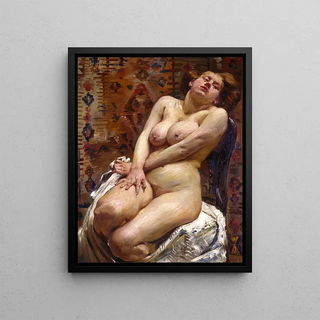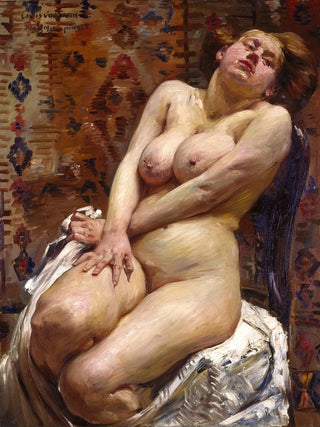Art print | Nana Nude Woman - Lovis Corinth


View from behind

Frame (optional)
Nana Femme nue Art print - Lovis Corinth – Captivating introduction
The artwork "Nana Femme nue" by Lovis Corinth is a masterpiece that embodies the quintessence of early 20th-century expressionist art. Gazing at this canvas, the viewer is immediately transported into a world where sensuality and feminine beauty are celebrated with rare intensity. The depiction of a nude woman, both vulnerable and powerful, provokes thought and fascination. Corinth, with his bold technique and vibrant palette, manages to capture not only the physical form but also the very essence of femininity. Every brushstroke seems to vibrate with an almost palpable energy, inviting a deeper exploration of human emotions.
Style and uniqueness of the work
Lovis Corinth's style is distinguished by his daring approach and his ability to blend realism and expressionism. In "Nana Femme nue," the way he plays with light and shadow creates an almost mystical atmosphere. The contours of the female figure are both fluid and defined, revealing an intimate understanding of human anatomy. The color, omnipresent and vibrant, evokes sensations of warmth and passion. This art print does not merely depict a woman; it tells a story, that of a beauty that transcends time. The shades of pink, blue, and yellow blend harmoniously, while the blurred background emphasizes the central figure, highlighting its importance. This stylistic choice gives the work an almost dreamlike dimension, where the viewer is invited to immerse themselves in a universe of sensations and reflections.
The artist and his influence
Lovis Corinth, born in 1858 in Tapiau in Prussia, is one of the emblematic figures of German art of the early 20th century. Influenced by masters such as Rembrandt and Van Gogh, he developed a personal style that combines tradition and modernity. Corinth was a pioneer in exploring themes of sensuality and mortality, often through portraits and nudes. His work profoundly marked his contemporaries and paved the way for a new approach to figurative painting. By integrating elements of Impressionism and the

Matte finish

View from behind

Frame (optional)
Nana Femme nue Art print - Lovis Corinth – Captivating introduction
The artwork "Nana Femme nue" by Lovis Corinth is a masterpiece that embodies the quintessence of early 20th-century expressionist art. Gazing at this canvas, the viewer is immediately transported into a world where sensuality and feminine beauty are celebrated with rare intensity. The depiction of a nude woman, both vulnerable and powerful, provokes thought and fascination. Corinth, with his bold technique and vibrant palette, manages to capture not only the physical form but also the very essence of femininity. Every brushstroke seems to vibrate with an almost palpable energy, inviting a deeper exploration of human emotions.
Style and uniqueness of the work
Lovis Corinth's style is distinguished by his daring approach and his ability to blend realism and expressionism. In "Nana Femme nue," the way he plays with light and shadow creates an almost mystical atmosphere. The contours of the female figure are both fluid and defined, revealing an intimate understanding of human anatomy. The color, omnipresent and vibrant, evokes sensations of warmth and passion. This art print does not merely depict a woman; it tells a story, that of a beauty that transcends time. The shades of pink, blue, and yellow blend harmoniously, while the blurred background emphasizes the central figure, highlighting its importance. This stylistic choice gives the work an almost dreamlike dimension, where the viewer is invited to immerse themselves in a universe of sensations and reflections.
The artist and his influence
Lovis Corinth, born in 1858 in Tapiau in Prussia, is one of the emblematic figures of German art of the early 20th century. Influenced by masters such as Rembrandt and Van Gogh, he developed a personal style that combines tradition and modernity. Corinth was a pioneer in exploring themes of sensuality and mortality, often through portraits and nudes. His work profoundly marked his contemporaries and paved the way for a new approach to figurative painting. By integrating elements of Impressionism and the






